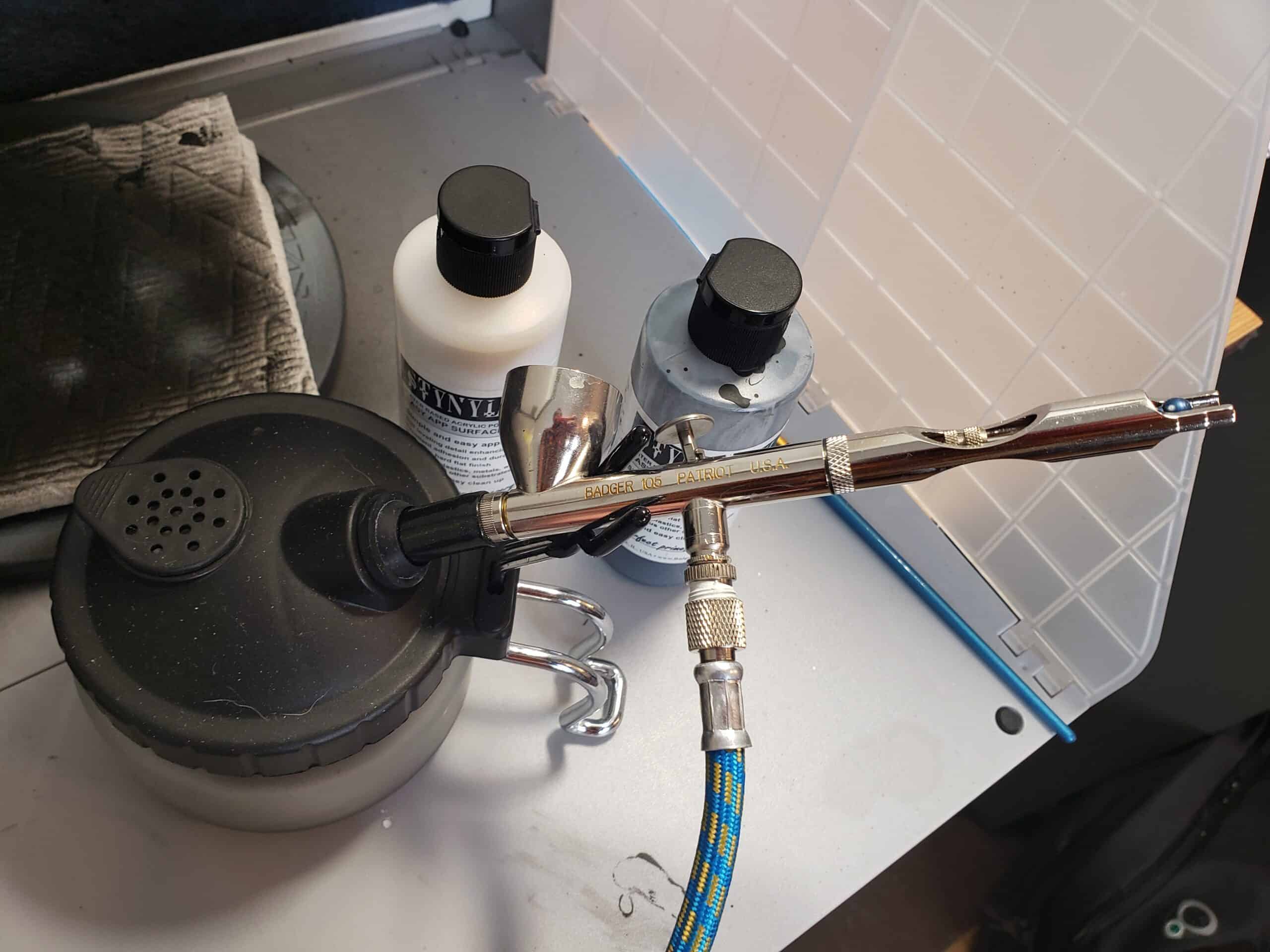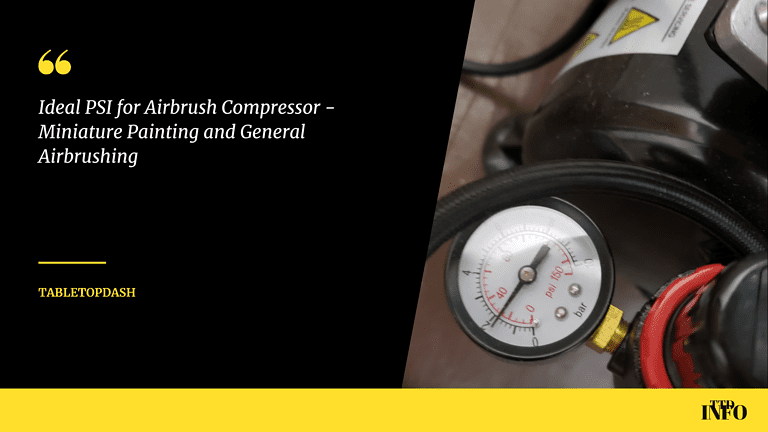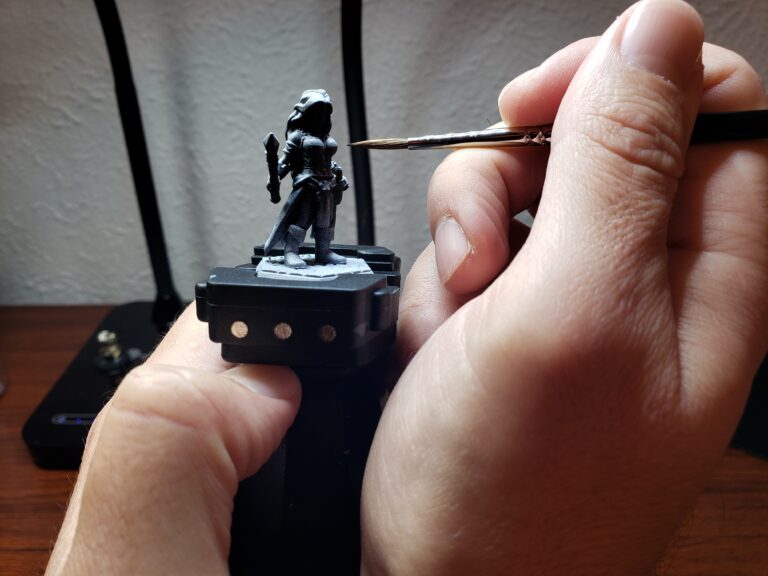2023’s 11 Best Airbrush Paints for Miniatures and Models (New Favorite this Year)
There are many brands of paint that are specially formulated for airbrush use, but you can use standard acrylic paints like vallejo and citadel as well. They typically require a good bit of thinning, so high quality acrylic paints work best. You want small, fine pigment, or you’ll get a speckled appearance and poor coverage when thinning.
The TableTopDash Best Airbrush Paint for Miniature and Model Painting was determined by the following criteria:
- Widely available for purchase (nothing exotic, discontinued or custom made)
- Used and tested by Miniature Painters over a period of no less than 1 year
- A significant number of reviews of the Airbrush Paints by verified users
- My Personal experience using airbrushes for miniature painting over the years
- Objective specifications that make Miniature and Model Painting easier such as high quality pigment in the paint, smooth application, able to be properly thinned for very narrow nozzle sizes.
11 Best Airbrush Paints for Miniatures and Models
The best airbrush paints are acrylics that flow very easily through your airbrush without clogging. They will give good coverage, smooth application, and are easy to work with.
- Tamiya Acrylic Paint: The New Top Choice in Airbrush Paints for 2023
- Vallejo Air Paint Set: Excellent value and quality, Airbrush Paint.
- Army Painter Starter Airbrush Paint Set: AP’s Airbrush set, no thinning required
- Citadel Base Paint Set and Citadel Layer Paint Set: Citadels standard acrylics, thinning is required for both.
- Citadel Air Paints: Citadel’s airbrush paint line, ready for airbrush use.
- Pro Acryl Base Paint Set :Pro Acryls fantastic acrylic paint line, not airbrush ready. Require thinning. (this is also our new #1 overall paint set)
- Vallejo Basic Paint Set: Vallejo’s Model Color line acrylic paints. Require thinning.
- Vallejo Game Color Set: Vallejo’s Game Color line of acrylic paints. Requires Thinning.
- Citadel Contrast Paint Set: Transparent paint that can be used as airbrush ready paints.
- Army Painter Mega Set: AP’s standard acrylic paints. Require thinning.
- Badger Minitaire Air Set: Badgers acrylic paints. Some thinning needed. (Depending on color)
#1 Tamiya Acrylic Paints: The Best Overall Airbrush Paints
Rich’s Take: The new king of airbrush paint for me is Tamiya. When it comes to how paint flows through your airbrush, and the result it gives me on my miniatures, Tamiya is FANTASTIC like no other paint I’ve tried. And I’ve tried a lot in my years painting miniatures. God tier paints.
I am talking buttery smooth, excellent coverage, and able to be thinned down to the barest hint of color. There are a couple of qualifiers here, but they are minor. One is that they require the Tamiya X-20A Thinners which contain butyl alcohol and n-propanol. You should be wearing a respirator anyway so this does not slow me down. The other consideration is the color selection. Tamiya has a good range of beautiful colors, some of my favorites, but if you’re looking for a very particular shade of blue for your Dragon or Ultramarine, Tamiya might not have it.
At a minimum, if you are searching for airbrush paint specifically, you should 1000% try these paints. This is my pick for best airbrush paint for miniatures. I recommend getting Tamiya Flat White to start along with the X-20A thinner. Try it, it’s an amazing white paint. Try a zenithal spray with it over black. You’ll see what I’m talking about. Another recommendation is Ocean Grey , which is gorgeous and helps you get to a more “real” and rich looking white.
Huge shout out to Andy Wardle from Cult of Paint, multiple Golden Demon winner. He was the first person I heard suggest these and he was absolutely spot on.
Tamiya Acrylic Paint Key Features and Specs:
Paint Type: Acrylic Paint
Airbrush Ready? No. They are not made to just pour and go. You could probably use it right from the jar in a larger nozzle airbrush head, but I would always thin them down personally.
Thinners used: Tamiya X-20A – You can also add in other mediums, I never had trouble adding a drop of flow improver for example.
Tamiya Acrylic Paint Likes and Dislikes
What I like: They are extremely smooth, can be thinned down to a whisper of color, and cover very well. They are also a matte finish which I personally love. I especially recommend the Tamiya Flat White. I have tried regular acrylic paint, inks, and white airbrush paint. Nothing is even close to the Tamiya Flat White for smooth application and coverage through an airbrush.
What I dislike: The thinner is a bit of a hassle. What I do is take a plastic dropper pipette and grab some Tamiya paint, then some X-20A thinner, and mix it in a small metal paint mixing cup. Then pour that into my airbrush.
#2 Vallejo Air Paint: The Best Airbrush Paint for Miniatures
Rich’s Take: When it comes to pure airbrush paint, meaning high quality acrylics ready to be used in an airbrush immediately out of the dropper, Vallejo Model Air paints are the best of the bunch. So by the definition of paint ready for use in an airbrush this set contains the best airbrush paint for miniatures.
I tend to go back to a few brands over and over, and Vallejo is one of them. Consistently high quality and value in their pricing. The air set is excellent and if you’re looking for a larger collection of airbrush paint this is the one I’d recommend.
I do not feel the need to thin these down at all, unless I’m going for a very transparent layer of paint. They spray smoothly and give good coverage. You also have the bonus of it being a perfect match for the standard Vallejo acrylic colors.
Many Vallejo Air sets come with Metallic colors, however I highly suggest you try one of the Vallejo Metal Colors if you’re looking to do a silver or steel through the airbrush. Those paints are S tier for a brush or airbrush. There are a lot of variations of the Metal Color series, the linked one is just an example. My favorites are: Gunmetal Grey, Steel, Silver and Copper.
Vallejo Model Air Paint Key Features and Specs:
Paint Type: Acrylic Paints
Airbrush Ready? Yes. These are ready to go out of the dropper. No thinning needed.
Thinners used: If you do need to further thin them and get a very light coverage, you can use water but airbrush thinner and flow improver are better options. Note the bigger Vallejo Air sets come with these mediums.
Vallejo model air paint Likes and Dislikes
What I like: I love Vallejo products because they are so reliable, and priced well. The air set is great because I can just reach for them and not worry about thinning in an external mixing cup. Just pour and shoot for the most part.
If you are painting miniatures, and especially if you’re doing a lot, say for an army, you want things to be easy. Pre made airbrush paint is a huge help.
What I dislike: My only complaint here is that air paint is just normal vallejo game and model color acrylics thinned down. So you’re paying for convenience. If you’re already using Vallejo when painting miniatures, you can simply add some airbrush thinner to those acrylics.
#3 Army Painter Airbrush Set
Army Painter Starter Airbrush Paint Set
Rich’s Take: These sets are great for a couple of reasons: Value and sheer number of paints. If you like to experiment, and you enjoy having a lot of options, this might be a good option for you. As I write this I’m thinking I should rate this higher actually. Hmm.
I think all miniature painting brands need to do sets like Army Painter. It takes the overwhelm of choosing specific colors out of it. They give you great colors, as well as primer and airbrush thinner.
As always, I recommend trying a couple of individuals or getting a smaller set before jumping in to buy 100. That said, if you know you want a lot, the big set might be your solution.
Army Painter Airbrush Paint Key Features and Specs:
Paint Type: Acrylic
Airbrush Ready? Yes. These are good to use straight out of the dropper, however you might want to thin them a bit depending on use case. The sets come with the Army Painter thinner which is fine.
Thinners used: The Army Painter gives you a bottle of their airbrush thinner in the sets. That works great, but you can use any airbrush thinner, flow improver or acrylic medium. Water is also ok but not ideal.
Army Painter airbrush paint Likes and Dislikes
What I like: They are airbrush ready, come in very handy sets, and they are a value option. I love all those things about AP paints. The way I look at it, there are situations you want inexpensive, and times you want the best of the best. Most of the time, inexpensive but still good quality, is what I need.
Once again I love sets. At least as a starting point. I want something that gives me a black, white, blue, red, etc. From there I can fill in whatever I need more of. A different shade of red, or a darker blue.
What I dislike: The big drawback here is maybe it’s overkill. If you are just starting out, still researching the best airbrush for miniatures, thinking about what airbrush kit you want, and then buy a huge set like this to go with it, it’s sometimes too much.
Look if you have the money to spend go for it! I would just say if you’re on a budget, be sure it’s what you need.
#4 Citadel Air Paint: Excellent Airbrush Paints
Rich’s Take: Citadel’s Air line is top tier airbrush paint. In fact if you prefer Citadel’s color range, these are every bit as good or better than Vallejo’s Air range. The only real issue is pricing. Citadel Air is roughly 30 cents per ml. Vallejo Air is around 18 cents per ml. So you’re looking at almost double for Citadel.
Here’s the thing though, if you’re doing a Warhammer 40k army and you need access to pre thinned airbrush paint in specific colors, Citadel Air is your best bet. The other thing is, if I want a pot of Evil Suns Scarlet paint for my airbrush to use on a specific project, yeah I’ll drop the 7 bucks for it.
At the end of the day it comes down to this: I own a fair amount (over 10) of pots of Citadel Air Paints. I wanted to base coat my Warhammer 40k Ultramarines in McCragge Blue. Not any other shade of blue. The best way to do that consistently over multiple miniatures was to grab a pot of McCragge Blue air paint.
Citadel Air Paint Key Features and Specs:
Paint Type: Acrylic Paint
Airbrush Ready? Yes. No thinning is required. I typically use this right out of the pot in my airbrush.
Thinners used: None. You can use water, airbrush thinner or flow improver, but it’s not needed.
Citadel Air Paint Likes and Dislikes
What I like: Convenience and color choices. I love Citadel paints. I love the color ranges, love the fact that Citadel develops paint specifically as shadows and highlights of other colors. I love that they have copious amounts of box art images you can reference. Including breakdowns of the colors used. It’s enormously helpful. If they cost the same or even close to Vallejo they’d be my clear favorite brand.
What I dislike: Just the price. Well and the pots as opposed to dropper bottles. Especially for an airbrush you want dropper bottles ideally. That said a simple plastic pipette will get the paint in your airbrush paint cup without hassle.
The last thing is again, for the airbrush you can simply thin down the standard acrylic paints and get nearly the same results.
#5 Citadel Base and Layer Paints
Citadel Base Paint Set and Citadel Layer Paint Set
Rich’s Take: Citadel base and layer paints are the standard line of acrylics. If you are painting miniatures you owe it to yourself to at least try Citadel paints. Of course I say that about a lot of brands. Find one you like and get some colors from their range. Then find other brands and try them.
I put them on the “best” list because they are very high quality. You can thin them down for an airbrush with no problem. Specialized airbrush paint isn’t needed.
The ratio I tend to use for my Badger Patriot 105 is:
5 drops of Citadel paint to 5 drops Airbrush thinner and 2 drops flow improver. Start there and thin more as needed. Each paint has it’s own consistency so you’ll need to add more or less depending on the specific paint.
Citadel Base and Layer Paint Key Features and Specs:
Paint Type: Acrylic Paint
Airbrush Ready? No. These paints require a fair amount of thinning. They are on the thicker side when out of the pot. They do thin down very well though and it’s why they make the list.
Thinners used: Water, airbrush thinner and flow improver are all ok to use on these.
Citadel Base and Layer Paint Likes and Dislikes
What I like: Again, when it comes to color choices, quality, and ease of use, Citadel is second to none. I love their color ranges, I love that they have box art and lists of paints used to reach those results. You can find information on shadow, mid tone and multiple layers of highlights for each shade they have.
In terms of quality: fantastic. Excellent coverage, beautiful results, and able to be thinned down to a fine glaze.
What I dislike: Price. It’s a recurring theme with Games Workshop | Citadel. The products are typically excellent, the price is high. Sometimes they will make a product that isn’t even remotely worth it, but the paints are not in that category.
Flat out, brands like Vallejo and Pro Acryl are better value (usually)
#6 Pro Acryl Paint Set
Rich’s Take: Pro Acryl Paints are AWESOME. Huge fan of them and recommended without hesitation. They are great quality, come in droppers, solid range of colors, smooth and easy to work with. You can also thin them down for airbrush use which is why they make this list.
If you are painting miniatures this is a brand that should be on your short list to try out. Both for brush and airbrush. When it comes to airbrush paints, you would thin these down to a consistency where it flows easily with no resistance. Not watery, but smooth and flows down the airbrush paint cup easily when you mix it.
Pro Acryl Paint Key Features and Specs:
Paint Type: Acrylic Paint
Airbrush Ready? No. These require thinning. They are roughly the consistency of Vallejo, maybe a touch thinner.
Thinners used: Water, airbrush thinner, or flow improver all work well. I would start with a ratio of 5 drops Pro Acryl, 4 drops airbrush thinner and 1 drop flow improver. Each color is different, and needle size of the airbrush matters, so you may need to adjust. Shoot for a consistency that flows easily through the airbrush.
Pro Acryl Paint Likes and Dislikes
What I like: These paints are top contenders for people who prefer to thin regular acrylic paints for airbrush use. I have a lot of Pro Acryl paints and they are my all time top 3 brands for painting miniatures. They’re that good.
Buy some that you like, thin them down, and try them in your airbrush. Great value.
What I dislike: They have a fair amount of colors but not near the breadth of range as Vallejo or Citadel. The only other issue might be availability. I’ll often find these are out of stock.
#7 Vallejo Model Color Set
Rich’s Take: These are the Vallejo normal acrylic paint range as opposed to the airbrush ready paints. They are not premixed model paint formulated for airbrushes. However like the Pro Acryl and Citadel paints, they can be thinned down for airbrush use.
If you don’t mind thinning these down, they are excellent acrylics for painting miniatures and models. I highly recommend at least trying Vallejo paints, and the Model color is my top choice.
As with the other standard acrylics you would be best served thinning these with airbrush thinner or flow improver, but water will work.
Vallejo Model Color Key Features and Specs:
Paint Type: Acrylic Paint
Airbrush Ready? No. These are standard acrylic consistency and need to be thinned for use in an airbrush.
Thinners used: You can use water, however airbrush thinner and/or airbrush flow improver or other thinning mediums will work better.
Vallejo Model Color Set Likes and Dislikes
What I like: Vallejo Model Color range is one of my all time top recommendations if you are painting miniatures. Just as a general principle you should be trying different brands so you can get a feel for what you like and what you dont. Vallejo is a staple brand that you should check out. Huge range of colors, and I love the more matte finish of the Model color line.
What I dislike: Same as the other standard acrylics, these are too thick and viscous to spray through an airbrush right out of the dropper bottle. You’ll need to thin them.
#8 Vallejo Game Color Set
Rich’s Take: As above, these are standard acrylics that need to be thinned for airbrush use.
The Game color range is the slightly more satin finish range from Vallejo. You’ll hear this a lot from me, but I don’t get hung up on brand or range. I pick colors and finishes I like, whatever they’re categorized as.
I probably have more Model color from Vallejo, but I absolutely have my favorites in the Game color range. For example I’m looking through my paint rack now and I’m seeing: Dark Fleshtone, Squid Pink, Royal Purple and Scrufulous Brown. I use all of these regularly! Can’t do without a lot of those.
If you’re picking your colors for a miniature, and you run into a Game color, you know it will thin down perfectly and be make great airbrush paints.
Vallejo Game Color Key Features and Specs:
Paint Type: Acrylic Paint
Airbrush Ready? No. These again are too thick and viscous for use in an airbrush straight away. Thin them down until they flow easily and then you can use them in your airbrush kit.
Thinners used: Water is ok, airbrush thinner and flow improver or some other thinning mediums are better.
Vallejo Game Color Likes and Dislikes
What I like: They’re Vallejo. I know they’ll be consistent and high quality. Easily available and have been used as miniature and model paints for a long long time. If you are airbrushing miniatures, you must have heard of Vallejo. Don’t hesitate to grab game color paints.
What I dislike: They are not airbrush ready paints. They also have a bit more satin finish which can be a good or bad thing. Remember than any finish can be varnished to change it to matte, satin or gloss as desired!
#9 Citadel Contrast Paints
Rich’s Take: You might be aware of contrast paints but not know they’re great through the airbrush. They are a thin consistency, and flow really well. There are a couple of important things to consider however:
First, you wont get a contrast effect if you use them in an airbrush. It will come out as more of a filter of the color you’re using. So if you use say, Iyanden Yellow, you’ll get a yellow filter. By filter I mean the paint is transparent by design. You’ll see what is underneath that layer.
Using Contrast Paint through an airbrush, you’ll want to pay close attention to the layers underneath. So for example spraying yellow over black wont give much impact. Yellow over white will be very bright.
The second thing to consider is cost. Contrast paint isn’t cheap. So if you’re looking to do a lot of miniatures, take this into consideration. Vallejo has a transparent line of paint that you can play with to see if it gives you what you’re looking for.
Citadel Contrast Paint Key Features and Specs:
Paint Type: Acrylic – Citadel sometimes calls these “technical paints”
Airbrush Ready? Yes you can use Contrast right out of the pot in an airbrush. You can thin as needed depending on the look you’re after.
Thinners used: Contrast typically uses Contrast Medium to thin down, however since we are not looking for the contrast effect here, you can use airbrush thinner or flow improver. Even a little water would be ok, but not ideal.
Contrast Paint Likes and Dislikes
What I like: Contrast paints through the airbrush flow like a dream. Very smooth and consistent. I know what I’ll get when I use them. They are situational, but a fantastic tool for my airbrush.
What I dislike: As I said above, they’re situational. You wont always use Contrast in your airbrush, and they are expensive. They are filters, so you wont be doing fine detail. Although they could see use as a glow effect.
#10 Army Painter Warpaint Mega Set
Rich’s Take: This set deserves a spot on the list because of the ease of use, value and versatility. They give you the colors you need, and at a good price. Again this is the standard acrylic line, so you’ll need to thin them. Army Painter paints thin down fairly well so you shouldn’t have much trouble there.
The benefit here is if you grab a set like this, you have options for brush work and airbrushing. The bigger sets are a value, and you’ll get paints for roughly $2 each. Vallejo’s smaller sets are cheaper, but you only get 16 paints.
Army Painter Warpaint Key Features and Specs:
Paint Type: Acrylic
Airbrush Ready? No. Army Painter standard acrylics are on the thinner side, compared to say Citadel or Vallejo, but they still require significant thinning for easy flow through an airbrush.
Thinners used: Any airbrush thinner or flow improver will work just fine. Water is also ok but not ideal.
Army Painter Warpaint Likes and Dislikes
What I like: Value and versatility. The sets offer pretty much everything you need color wise. The standard acrylic paints are useful for both brush and airbrush work. So you don’t have to stress about only having it for airbrush paint.
What I dislike: Army Painter isn’t the only brand out there so to have a huge box of them isn’t ideal. I’d rather pick and choose the ones I like from each brand. I don’t recommend blowing your whole paint budget on a giant set before trying at least a few of the brands.
#11 Badger Minitaire Paint Set
Rich’s Take: Yes that is spelled correctly. Minitaire not Miniature.Rather than bump these paints off the list completely, I made them number 11 🙂 I’m a fan of Badgers products, the Patriot 105 has been on my list of best airbrush for miniatures since the beginning, the primers are great, and these paints flow nicely. They are ready to go out of the jar, and come in a good size set. The price is solid too for the amount of paint you’re buying.
I would categorize these as really good for base coating, undercoats, terrain, and larger airbrush projects. You can do fine detail with them as well, it’s just a limited color palette without mixing.
Key Features and Specs:
Paint Type: Acrylic paints
Airbrush Ready? Yes.
Thinners used: None
Badger Minitaire Likes and Dislikes
What I like: These are true airbrush ready paints. Ready to pour in your airbrush paint cup and go. A good price, good airbrush brand by people who know what they’re doing.
What I dislike: The only problem with airbrush ready paints is that they are pre-thinned and you can’t use them as easily with a brush.
What is Airbrush Paint?
Airbrush paint is any paint that can be applied via the airbrush. In miniature painting we typically use a gravity feed airbrush, pour paint in the airbrush paint cup, and spray. This requires a paint thin enough to flow through the mechanism. Airbrush ready paints are pre-thinned to allow easier flow through the airbrush.
Do You Need to Use Airbrush Paints in an Airbrush?
No. You do not need to use paints specifically labeled as “Airbrush Paints” in an airbrush. You just need any paint that can flow through the narrow openings of an airbrush. Most paints can be thinned to a consistency that allows for airbrush use.
Which Airbrushes Work Best for Miniature Painting?
Miniature painters typically will use a dual action, gravity feed airbrush. The best airbrush for miniatures and models would be a Badger Patriot 105 or Iwata HP-CS airbrush.
Considerations for Selecting the Best Airbrushes for Miniatures and Modeling
The major consideration for choosing the best airbrush is what you will use the airbrush for. Different actions require different specifications. Generally your choice is needle/nozzle size. The standard ranges in miniature and model painting would be from as small as .2 mm and as large as .6 mm.
Smaller sizes are good at precision and fine detail. Larger sizes offer smooth application and volume (therefore speed). Airbrush painting miniatures can fall into the following tasks:
Priming: Applying primer can be done by any size needle, but larger is typically preferred.
Base Coating: Similar to priming, it is easier with a larger needle.
Varnishing: Another task that lends itself to larger sizes.
Fine Detail: Here you want a narrow aperture so you can get smaller applications of paint.
Thinning Acrylic Paint with Airbrush Thinner: Ratios and Goals
When you thin acrylic paints your goal is a free flowing paint with no resistance. Your ideal consistency is dependent on your needle size, since smaller openings require thinner paint.
Your consistency is also dependent on paint brand, or even individual paint itself. Each color and formulation is different, and pigment size makes a difference.
Finally, you want to consider the look you’re trying to achieve: If you want a full coverage result, you can either go a bit thicker, or (often better) is multiple coats of thin layers.
Some starting ratios for you are:
Vallejo Model Paint: 10 drops Vallejo Model Paint, 5 drops Airbrush Thinner, 3 drops Flow improver.
Citadel Paint: 10 drops Citadel Paint, 6 drops Airbrush Thinner, 4 drops flow improver
Reaper Paint: 10 drops Reaper Paint, 4 drops Airbrush Thinner, 3 drops Flow Improver.
How to thin miniature paints for airbrush use
Thinning acrylic paints for airbrush use is as simple as adding a compatible medium to the paint. You want your paint to have no resistance to it as it flows through the airbrush. Some people like to think of it as the consistency of skim milk. It’s not watery, but it’s fairly close.
Typically acrylics are thinned with: Airbrush thinner, airbrush flow improver, or water. Thinner is as it implies, just an acrylic medium. Adding more will dilute the paint, and give it better flow.
Flow improver has a paint retarding component which accomplishes two things: Thinner paint, and slower dry time. This aids with preventing paint drying inside the airbrush body or on the needle tip.
Water is fine to use, but often not ideal. The paint pigment doesn’t distribute as evenly in water and you might get an inferior finish.
I often use a 5:1 ratio of flow improver to water on my desk for brush work, that can easily be used to thin acrylics for an airbrush as well.
What’s the difference between “airbrush-ready paint” and “regular model paint”?
Airbrush ready paints are simply thinned down versions of “regular” model paints. They are made to flow easily through your airbrush. If your airbrush paint kit says “airbrush ready” that’s all it’s trying to imply.
Thinner paint is required for fine detail airbrushes or airbrush kits.
Varnishing (sealing your model)
Varnishes are typically thin enough to flow through an airbrush as is. No thinning is required for the most part. I use Pro Acryl Ultra Matte Varnish primarily and do not thin it for an airbrush.
Other controls on Airbrushes for Miniature Painting
Some airbrush kits have other controls on them. Specifically one of the best airbrush for miniatures, the HP Hi-Line series, has a MAC valve on it. This is just a secondary way to regulate the air pressure coming from the compressor.
Other airbrush kits have various ways of limiting how far back you can pull the needle. This helps you limit the range of motion if you’re looking to do very short pulses.





